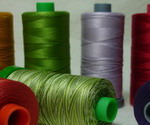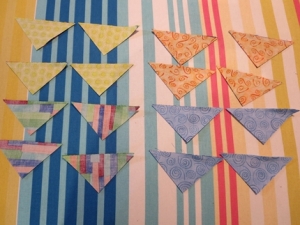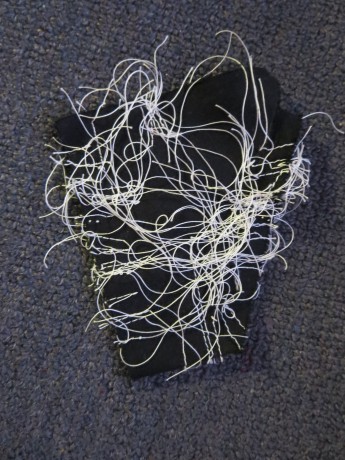At the beginning of this year, I celebrated the birth of my first grandchild, and like quilting grannies through the generations, wished to mark the occasion with the creation of a quilt.
I decided to ignore all the beautiful baby quilt patterns available commercially and design my own quilt using the pinwheel block with three narrow borders, using bright fabrics on a white background.
 To make the pinwheel block I used a technique where you start with squares.
To make the pinwheel block I used a technique where you start with squares.
You take 2 squares of contrasting fabric and sew them right sides together, with a 1/4 inch seam all the way around the edge.
Then you cut the joined squares on each diagonal, being careful not to move the squares out of alignment as you rotate. (Tip: move your cutting mat around, not the squares, or better still, invest in a rotating mat!)
Press the seams on your triangles, firstly as closed seams, then open them out and press with the seam in the direction of the darker fabric.
At this point you will have four matching squares which you arrange to form the pinwheel design and then sew together. 
Sorry, I forgot to take a photo of this when I was making my quilt so the sample looks a little different.
If you wish to see a video of this technique and find out how large to cut your squares to reach the desired block size go to http://blog.missouriquiltco.com/update-on-the-easy-pinwheels/ You may notice that there is a great deal of confusion about the cutting size required to obtain the pinwheel square you require. The following method is accurate:
Take the finished size you wish your block to be (i.e. without any seam allowance)
Multiply by 1.41
Divide by 2
Add 1.25
Round up/down to the nearest eighth of an inch.
This will make a block which includes seam allowance so that when you have joined it to its neighbouring blocks it will be the accurate size.
I needed to make 50 pinwheel blocks and cut 49 intervening plain white ones.
Having done that, I then arranged them in a pleasing layout. In the photo below I have mine pinned to an old sheet. Theoretically no two blocks were supposed to be the same, but there are two that are!!
I then added the borders:a narrow plain white border, a pieced border using strips of all the fabrics used in the quilt, and finally another narrow white border. I also used white fabric to bind the quilt. This gave the effect of the pinwheels and border “floating” on the white background.
To quilt the quilt I used a design called Curlz by Patricia Ritter. Throughout the quilt, for piecing and quilting, I used Aurifil Cotton Mako 40.
Ta Da!! My completed quilt.
Filed under: Cotton Mako', Cotton Mako' Ne 40, Home page, Quilting | Tagged: Aurifil, Cotton Mako 40, machine piecing, machine quilting, Pinwheel block, Quilt block calculations | 2 Comments »



































